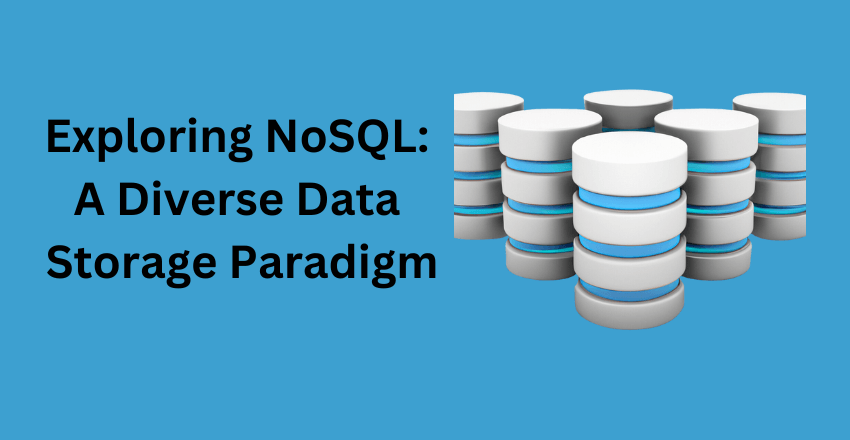
NoSQL databases (NoSQL D) excel in performance and high availability, perfect for businesses needing to manage unstructured data effortlessly.
In today’s world of data storage and management, the traditional relational database paradigm is no longer sufficient to meet the diverse needs of modern applications. Enter NoSQL, a non-relational database paradigm that offers greater flexibility, scalability, and adaptability in handling complex and varied data sets.
Unlike relational databases, NoSQL databases do not rely on a fixed schema and structured querying language, allowing them to handle unstructured and semi-structured data more efficiently. Additionally, NoSQL databases offer a range of different types, each with its unique characteristics and use cases.
Key Takeaways
- NoSQL is a non-relational database paradigm that offers greater flexibility, scalability, and adaptability than traditional relational databases.
- NoSQL databases do not rely on a fixed schema and structured querying language, allowing them to handle unstructured and semi-structured data more efficiently.
- There are different types of NoSQL databases available, each with its unique characteristics and use cases.
Understanding NoSQL: A Break from Relational Databases
NoSQL is a term used to describe non-relational databases, a new paradigm in data storage and management. Compared to traditional relational databases, NoSQL focuses on flexibility and scalability, making it an excellent choice for modern applications that require large amounts of data and flexible schema.
Data modeling in NoSQL is different from the traditional relational database approach. NoSQL databases do not need to adhere to a rigid schema and do not require data to be categorized into predetermined tables. Instead, data can be stored in a more flexible format, allowing for easier adaptability as business needs change.
Scalability is another advantage offered by NoSQL databases. Horizontal scalability allows for increased performance and capacity by adding more nodes to the system, rather than upgrading to more powerful hardware. This enables businesses to manage and process large volumes of data in a cost-effective manner.
In summary, NoSQL databases provide a break from traditional relational databases, offering greater flexibility and horizontal scalability. Adopting NoSQL can lead to improved performance and greater data handling capabilities in modern applications, making it an essential addition to any organization’s data storage strategy.
If you’re still struggling to grasp the concepts, here’s an example of SQL code for a simple query:
SELECT * FROM Customers WHERE Country='USA';
The Types of NoSQL Databases
NoSQL databases offer a range of options for data storage, each with its own unique structure and use cases. Here, we’ll explore some of the most common NoSQL types:
Key-Value Stores
Key-value stores are one of the simplest NoSQL database types, consisting of a collection of key-value pairs. These databases are ideal for handling large volumes of unstructured data, such as session information, user profiles, and caching data. Examples of key-value stores include Riak and Redis.
Document Databases
Document databases store data in JSON-like documents, making them ideal for managing semi-structured data such as product listings, blog posts, and user-generated content. These databases are highly scalable and offer flexible data modeling. MongoDB and Couchbase are popular document databases.
Column-Family Stores
Column-family stores structure data into column families, which comprise columns and column values. These databases are designed to handle large amounts of data with varying data structures and provide efficient storage and retrieval of data for big data analytics. Cassandra and HBase are popular column-family stores.
Graph Databases
Graph databases store data in nodes and edges, allowing for complex relationships and interactions to be modeled effectively. These databases are ideal for applications that require advanced data analytics, such as social networks, recommendation engines, and fraud detection systems. Examples of graph databases include Neo4j and OrientDB.
Benefits of NoSQL Databases

NoSQL databases offer a range of benefits over traditional relational databases, making them increasingly popular among modern businesses and developers. Here are some of the key advantages:
- Flexibility: NoSQL databases provide greater flexibility when it comes to data handling and storage. Unlike relational databases, there is no pre-defined schema, allowing for easier adaptation to changing data structures and formats.
- Horizontal scalability: NoSQL databases are designed to scale horizontally, meaning that they can easily handle larger amounts of data by adding more nodes to the system. This allows for greater scalability and performance, making it an ideal solution for businesses handling big data.
- Schema-less design: With NoSQL, there is no need to define a schema prior to data insertion. This allows for faster development and deployment, as well as easier management of unstructured data.
These benefits make NoSQL databases an attractive option for businesses looking to handle large amounts of data with flexibility and scalability.
Example SQL code:
To illustrate the flexibility of NoSQL databases, consider a scenario where a business needs to store customer data. With a traditional relational database, the schema needs to be carefully defined before any data can be inserted. This can be time-consuming and inflexible, making it difficult to adapt to changing needs. In contrast, with a NoSQL document database, data can be inserted without defining a schema beforehand. This allows businesses to quickly and easily adapt to changing data structures, ensuring that the database remains relevant and reliable over time.
Common Use Cases for NoSQL Databases

NoSQL databases have become increasingly popular due to their ability to handle large volumes of unstructured and semi-structured data, making them suitable for a variety of use cases. Let’s take a look at some common scenarios where NoSQL databases excel.
Handling Big Data
NoSQL databases are designed to handle vast amounts of data, making them a popular choice for big data processing. With their ability to store and retrieve massive amounts of data quickly and efficiently, NoSQL databases can help organizations streamline their data processing and analysis operations.
Example: A healthcare organization could use a NoSQL database to store and analyze patient data from multiple sources, such as medical records, insurance claims, and wearable devices, to gain insights into patient health trends and improve patient outcomes.
Real-Time Analytics
NoSQL databases are well-suited for real-time analytics, allowing organizations to process and analyze data as it is generated. This real-time capability helps organizations make more informed decisions based on up-to-date information, without having to spend time waiting for batch processing.
Example: An e-commerce company could use a NoSQL database to track customer behavior in real-time, allowing them to personalize the customer experience and offer targeted promotions based on current shopping patterns.
Content Management Systems
NoSQL databases are ideal for content management systems that require flexible schemas and support for unstructured data. With NoSQL, content can be stored in a variety of formats, including JSON, XML, and binary data, making it easier for organizations to handle a wide range of content types.
Example: A media company could use a NoSQL database to manage content from various sources, including images, videos, and articles, all stored in a flexible, scalable format that allows for easy access and retrieval.
Overall, NoSQL databases offer unique advantages for a variety of use cases and are becoming increasingly popular for their ability to handle large volumes of data quickly and efficiently.
Challenges of NoSQL Adoption

While NoSQL databases offer numerous benefits, there are also challenges that organizations may face when adopting this technology.
Lack of Standardization
One of the main challenges of using NoSQL databases is the lack of standardization across different types of databases. Because there is no established industry standard, each database has its own syntax and API, making it difficult to transfer knowledge and skills between different systems.
Limited Query Capabilities
Another challenge of NoSQL databases is that their query capabilities may be limited compared to traditional relational databases. Some NoSQL databases may not support complex queries, such as multi-table joins and aggregations, which can be critical for some applications.
Data Consistency
Ensuring data consistency can be a challenge with NoSQL databases, particularly with distributed databases that replicate data across multiple nodes. It can be difficult to ensure that changes made in one node are accurately reflected in all nodes, leading to inconsistencies that can compromise data integrity.
Despite these challenges, many organizations have successfully adopted NoSQL databases by carefully evaluating their requirements and selecting the appropriate technology.
Best Practices for Implementing NoSQL Databases

Proper implementation is crucial to ensure the database performs optimally and seamlessly integrates into your existing infrastructure.
Data Modeling
NoSQL databases require a different approach to data modeling compared to traditional relational databases. It’s important to understand the data access patterns and structure your data accordingly. Denormalizing your data can often lead to better performance. Modeling your data based on access patterns and not on relationships can lead to a schema-less design, which is one of the core benefits of NoSQL.
Indexing
Understanding the data access patterns can help you determine the type of indexes required. It’s important to use indexes efficiently to avoid impacting performance and storage requirements. Consider using composite indexes for fields frequently used together.
Backup and Recovery
Make sure to plan for disaster recovery scenarios and perform regular backups. Test backups regularly to ensure that they can be restored and are functional within your infrastructure. Automate your backups to ensure that you have up-to-date data and that backups are performed on a consistent basis.
It requires careful planning and preparation to ensure that your database meets your business needs. Understanding data modeling, indexing, and backup and recovery processes can help you design and implement a NoSQL database that performs optimally and meets your business requirements.
Examples: Successful NoSQL Implementations
Here are some notable examples:
| Company | Use Case | NoSQL Database |
|---|---|---|
| Netflix | Real-time analytics and content recommendations | Cassandra |
| Uber | Handling large amounts of ride and location data | Redis and Cassandra |
| Amazon | Product catalog and inventory management | DynamoDB |
For example, Netflix relies on Apache Cassandra to store and process data from millions of users in real-time. This allows them to offer personalized content recommendations and optimize their streaming service based on user behavior.
Similarly, Uber’s use of both Redis and Cassandra enables them to handle millions of rides and location data points per day, ensuring a seamless experience for both drivers and riders.
Amazon’s adoption of DynamoDB has allowed them to efficiently manage their vast product catalog and inventory, ensuring accurate and timely updates across their different platforms.
These success stories highlight the value and potential of NoSQL databases in modern data management, and serve as inspiration for organizations considering implementing NoSQL databases.
Conclusion
Overall, NoSQL databases offer a diverse and flexible data storage paradigm that addresses many challenges faced by traditional relational databases. With its schema-less design and horizontal scalability, NoSQL provides a robust foundation for modern applications.
While NoSQL databases present challenges such as limited query capabilities and data consistency, organizations can overcome these hurdles by following best practices for implementation such as proper data modeling, indexing strategies, and backup and recovery processes.
Looking towards the future, the popularity of NoSQL is expected to continue to grow with the rise of big data and the Internet of Things. As more organizations recognize the benefits of NoSQL, we can expect to see continued innovation and development in this domain.
Join our team of dedicated SQL Developers
At HireSQL, we provide top-quality outsourcing services for companies in need of dedicated SQL developers. Whether you need assistance with data management, database design, or migration to a NoSQL environment, our team is here to help you achieve your goals. Contact us today to learn more!
SQL Code Example:
SELECT column_1, column_2 FROM table_name WHERE column_1 = 'value';FAQ

Q: What is NoSQL?
A: NoSQL, short for “not only SQL,” is a diverse data storage paradigm that is used to store and manage non-relational databases. Unlike traditional relational databases, NoSQL databases do not rely on fixed schemas and provide flexible data structures for storing and retrieving data.
Q: What are the different types of NoSQL databases?
A: There are several types of including key-value stores, document databases, column-family stores, and graph databases. Each type has its own unique characteristics and is best suited for specific use cases.
Q: What are the benefits of using NoSQL databases?
A: They offer several advantages, including greater flexibility in handling diverse data types, horizontal scalability for handling large amounts of data, and the ability to easily adapt to changing application requirements due to their schema-less design.
Q: In what use cases are NoSQL Ds commonly used?
A: Are commonly used in scenarios such as handling big data, real-time analytics, and content management systems. They excel in situations where high scalability, flexibility, and rapid data access are required.
Q: What challenges can organizations face when adopting NoSQL databases?
A: A lack of standardization, limited query capabilities compared to traditional relational databases, and ensuring data consistency in a distributed environment.
Q: What are the best practices for implementing NoSQL Ds?
A: A careful data modeling to match the specific use case, implementing efficient indexing strategies to optimize query performance, and establishing robust backup and recovery processes to safeguard data.
Q: Can you provide examples of successful NoSQL implementations?
A: Netflix, Airbnb, and LinkedIn. These companies have leveraged NoSQL to handle massive amounts of data, achieve high scalability, and improve application performance.
Sarah is an accomplished author, esteemed for her expertise in the field of data science and her engaging written works that cater specifically to the data industry. Residing in the vibrant city of London, she embarked on an academic journey at Cambridge University, where she immersed herself in the world of mathematics. This foundational education formed the bedrock of her illustrious career.
Driven by a desire to broaden her horizons, Sarah sought new challenges and opportunities, leading her to embrace a pivotal role at NetApp, a renowned data storage consultancy firm. In this capacity, she thrived in the dynamic landscape of data architecture, devising innovative strategies to optimize data storage, retrieval, and management for a diverse range of clients. Sarah’s intricate understanding of the intricacies of data systems and her ability to craft tailor-made solutions earned her accolades and solidified her reputation as a sought-after industry expert.
Beyond her professional pursuits, Sarah gracefully balances her roles as a devoted mother and an accomplished equestrian. She finds immeasurable joy in nurturing her daughter, guiding her through the intricacies of life, and instilling a love for knowledge and creativity. Sarah’s dedication to both her family and her career exemplifies her unwavering commitment to excellence in all facets of life.







